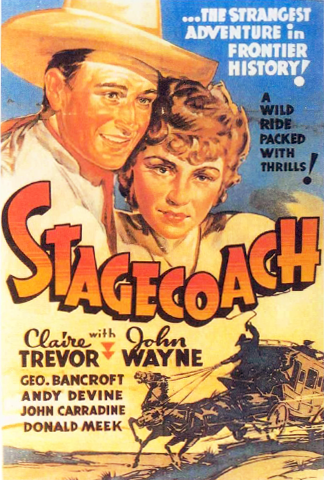1939 was a classic year for classic movies, bringing about some of the greatest and most timeless entries ever put on celluloid such as GONE WITH THE WIND, MR. SMITH GOES TO WASHINGTON, THE WIZARD OF OZ, and this independently-produced big-budget Western helmed by John Ford, his first in the genre since the silent film 3 BAD MEN (1926).
Taking place in June 1880, the film follows a group of strangers in the Arizona Territory who board a titular stagecoach en route to Lordsburg, New Mexico. To get there, they must travel through the treacherous territory of the Apache tribe, where their leader Geronimo is on the warpath. Meanwhile, the coach comes across the infamous Ringo Kid (John Wayne), who has broken out of prison in search of the man who killed his father and brother and to clear the wrongful accusations against his name.
The basic plot itself is simple enough, but where STAGECOACH really shines is in its wide array of characters, especially Wayne as Ringo, who absolutely shines in a role very much made for the part—and one for which Ford would not budge on the casting. The rest of the party includes Dallas, a prostitute (Claire Trevor); Hatfield, a gambler (John Carrdine); Doc Boone, a drunk doctor (Thomas Mitchell); Lucy Mallory, a pregnant woman trying to return to her military husband (Louise Platt); Samuel Peacock, a whiskey salesman (Donald Meek); Henry Gatewood, a crooked banker (Berton Churchill); Buck, the stage’s buffoonish driver (Andy Devine); and Marshal Curley Wilcox, their straightforward guard (George Bancroft). Each member of the cast has his or her unique flaw, but far beyond such flaws, this film shows that each one is innately human.
STAGECOACH sometimes deviates from its main focus on the perilous journey to give us some pertinent backstory on all of these personas as well as the relationships that ultimately evolve between the stage’s occupants, particularly that between Ringo and Dallas. However, it doesn’t bog us down too much in exposition, and manages to give us enough information on each character even if many of them don’t have a large amount of screen time. This already takes it far beyond how most Westerns were produced at that time, as almost exclusively action-driven stories between white-hat heroes and black-hat villains. In any event, the film never loses sight of its main plotline, and this results in an extended chase scene that is as captivating now as it was in 1939. Also, Ford partially shot the film in Monument Valley on the Arizona-Utah border using authentic stagecoach roads, and while not perfect (indeed, some of the film was of course shot on several movie ranches in California) they are no less breathtaking and add to the captivating nature of the film.
An unequivocally iconic and groundbreaking Western, STAGECOACH has influenced generations of filmmakers from CITIZEN KANE to RAIDERS OF THE LOST ARK with its masterful balance of story, cinematography, direction, action, and empathetic characterizations.
